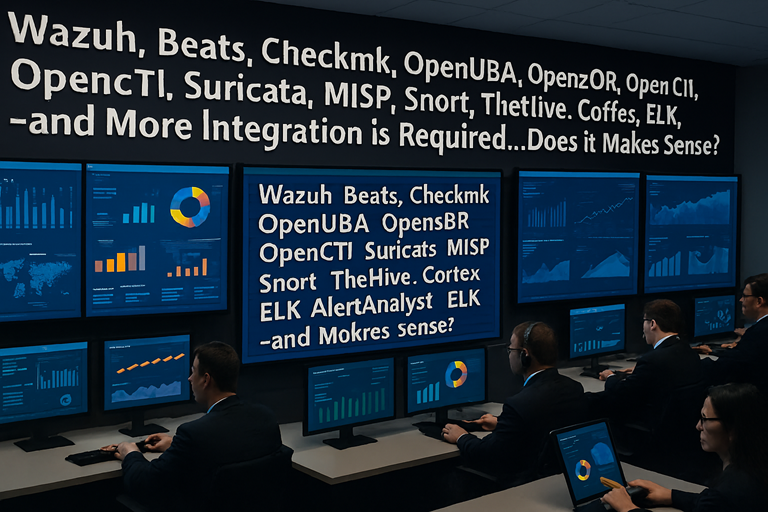
Status: Executive Summary
Author: Shahab Al Yamin Chawdhury
Organization: Principal Architect & Consultant Group
Research Date: MArch 23, 2021
Version: 1.0 (Summary)
I. Executive Verdict & Strategic Recommendations
The Core Question: Does This Integration Make Sense?
The decision to build a security platform from open-source components is conditional. It is a strategically sound choice for organizations with a high-maturity engineering culture and a long-term commitment to building a bespoke product. For all others, it represents a significant financial and operational risk. This is not a tool deployment; it is a multi-year software development initiative.
Key Findings
- Unmatched Capability: When fully integrated, the stack’s capabilities can rival or exceed commercial SIEM/XDR/SOAR platforms, offering deep, customized control.
- Monumental Complexity: Success hinges on a massive, continuous engineering effort to unify disparate data formats, build custom pipelines, and manage over a dozen distinct components.
- Deceptive Cost: The “free” license model shifts costs from software licensing to a substantial and perpetual operational expense for a large, specialized engineering team. Personnel costs can account for nearly 70% of the 5-Year Total Cost of Ownership (TCO), estimated at over $7 million.
Primary Recommendations
- Adopt a Phased Implementation: Begin with a foundational SIEM core (ELK, Wazuh, Suricata) to achieve initial visibility (Phase 1). Layer on SOAR (TheHive, Cortex) and Threat Intelligence (MISP) next (Phase 2). Reserve advanced analytics (OpenUBA) for the final stage (Phase 3).
- Mandate the Elastic Common Schema (ECS): Data normalization via ECS is a non-negotiable prerequisite. It is the only way to enable effective cross-source correlation and threat hunting. This must be enforced in all data ingestion pipelines from day one.
- Secure Sponsorship for a Dedicated Engineering Team: The project requires a permanent “Security Platform Engineering” team with expertise in DevOps, data engineering, and security development. This is the single most critical success factor.
II. The Integrated Architecture at a Glance
Component Roles & Data Flow
The platform functions by integrating specialized tools into three primary data pathways:
- Pathway 1: Feeding the SIEM: Telemetry is collected from endpoints (Wazuh), networks (Suricata), and infrastructure (CheckMK). Data shippers (Beats) forward this data to a processing layer (Logstash), where it is normalized to the ECS standard and stored in the central data lake (ELK Stack).
- Pathway 2: Automating Response: Alerts from the ELK Stack create cases in the incident management platform (TheHive). Analysts use TheHive to trigger automated analysis and enrichment on observables (IPs, hashes) via the automation engine (Cortex).
- Pathway 3: Enriching Investigations: TheHive and Cortex are integrated with threat intelligence platforms. MISP provides operational Indicators of Compromise (IoCs) for real-time enrichment, while OpenCTI offers strategic context on threat actors and campaigns.
Key Architectural Decision: Standardize on Suricata over Snort for network monitoring. Its native multi-threading and structured EVE JSON output dramatically simplify integration and improve performance.
Synthesized Capability Matrix
| Role in Architecture | Key Components | Core Function |
| Central Data Lake & Analytics Engine | ELK Stack (Elasticsearch, Logstash, Kibana) | The single source of truth for all security data; the primary interface for analysis. |
| Endpoint & Network Telemetry | Wazuh, Suricata, Beats | Provides deep, host-level and network-level security data. |
| Incident Workflow & Automation | TheHive, Cortex | Manages the incident response process and executes automated analysis/response tasks. |
| Threat Intelligence Management | MISP, OpenCTI | Manages and disseminates operational IoCs and strategic threat intelligence. |
| Advanced Analytics & Future State | OpenUBA, AlertAnalyst (Concept) | A framework for building custom ML-based detections and AI-driven alert triage. |
III. The Strategic Bottom Line: Build vs. Buy
When Does This Approach Make Sense?
- High-Maturity Organizations: Companies with an established DevOps/SRE culture can extend their practices to this security stack.
- Unique, Unmet Requirements: When commercial tools cannot meet highly specific data processing or integration needs.
- Long-Term Strategic Investment: For large enterprises seeking to build a competitive advantage through a fully customized, vendor-independent platform.
When is it a High-Risk Endeavor?
- Limited Engineering Talent: The project will fail without the required in-house DevOps, data engineering, and development skills.
- Need for Rapid Time-to-Value: The ROI is measured in years, not months. Commercial products are far faster to deploy.
- Strict Compliance Needs: Building and certifying a custom platform for regulations like PCI DSS or HIPAA is slow and expensive.
Final Verdict: The decision hinges on a strategic trade-off. Organizations must choose between the unparalleled customization and control of a bespoke solution and the significantly higher operational complexity, risk, and long-term TCO associated with its development and maintenance. Treat this as a product to be built, not a project to be completed.